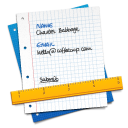You might consider this tab to be full of “Global Properties.” The options within are very similar to those found in the Property tab, but they apply to the entire form. Here’s an overview of what each option does for your form.
Color
The background color used for the entire form. Check the “Transparent” box if you don’t want to use a color (which can be useful for forms embedded in a website). Note that if a background image is used, this color will not be visible.
Background
The image that will be used in the background of the form. Click the + button to add an image, or click the - button to remove a selected image.
Using the three drop-down menus in this section, you can choose the horizontal and vertical alignment and starting point in pixels for the background image, as well as the image’s repeat behavior.
Border
Select a border style, thickness, and color that will surround the entire form.
Font
Select the font, font size, and font color to be used for all field labels.
Label Position
The position and/or alignment of all field labels. Labels can be left- or right-aligned to the left of each field, or positioned above each field.
Item Width
Determines the width of all newly created items.
Form Width
The total width of the form. Standard themes use pixels, while responsive themes use percentages.
Max. Width
When using a responsive theme, this form option appears and gives you the ability to configure a maximum width. Your form will never be wider than this number of pixels.
Customize margins
Check this box to adjust the margin around the outside border of the form (the space between the form and other content on a webpage, or between the edge of the form and the edge of the browser window in full-page forms). Values entered are in pixels.
Autofocus
Choose an element where the cursor will be automatically placed when the form is loaded. This option gives your users a starting point.
Max. Errors
Limits the number of errors that show on a form at any given time. Error messages add length to your form, and if space is a concern or you don’t want 8 errors potentially showing at once, you can set a maximum amount of errors that can be shown at once.
Hide Hints
Hide all the “Friendly Hints” shown on the form without erasing the messages entered into those fields.
Hidden Fields
Sometimes you want information to be passed along without needing the user to see it. If this is the case, you can add information by clicking the + button and entering a “Name” for your hidden field and then supplying its “Value” as well. You can remove a hidden field later by highlighting it and clicking the - button.
Reset Global Styles
Elements come equipped with a default style determined by your selected theme. Web Form Builder gives you the freedom to style those elements using your own discretion. However, you might take a look at your finished form and wish you had those default styles again!
Rather than starting over from scratch, you can click the Reset Styles button to return styling values to their defaults, effectively preserving your content. The elements you created will remain in the order and layout you chose, with all of their labels, placeholders, hints, and other text elements intact. Now you can try your hand at styling those elements again without having to redo everything.


